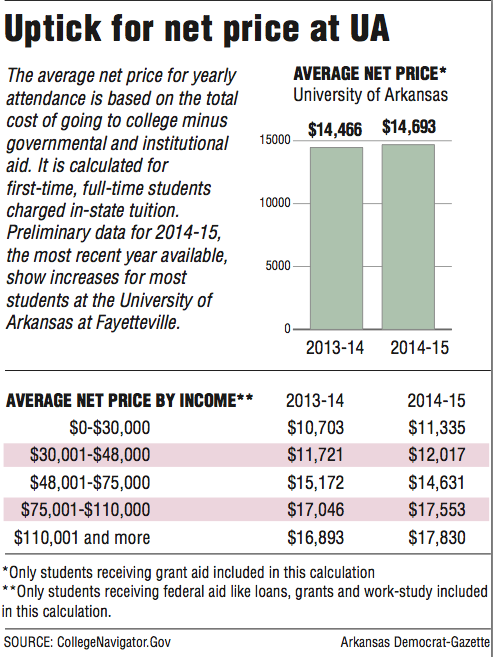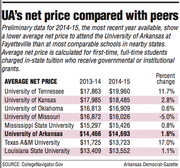FAYETTEVILLE -- An estimate of the true cost to attend college increased by less than $250 for the University of Arkansas at Fayetteville's 2014-15 academic year, the most recent year with data available.
UA's average net price of $14,693 for 2014-15 reflected a 1.6 percent increase over the school's $14,466 average net price for the previous year, according to preliminary data at the governmental website CollegeNavigator.gov.
Average net price is an expenses-minus-aid calculation for students receiving grant or scholarship awards. It takes into account additional expenses beyond tuition and fees while subtracting out what students receive, on average, in governmental and institutional grant awards.
Each year colleges publish an estimate of their total cost of attendance, factoring in both billed costs and indirect expenses. For in-state undergraduate students at UA in 2014-15, the estimated necessary yearly expenses totaled $23,066.
The total for the 2016-17 academic year is $24,302, including $8,820 in tuition and fees and $10,332 in room and board. UA System trustees in May approved a 3.5 percent increase in tuition and mandatory fees for the Fayetteville campus and increases of a few hundred dollars for several room-and-board options, including the least expensive double-occupancy rooms.
Joseph Steinmetz, UA's chancellor since Jan. 1, has called it a priority for UA to increase its need-based scholarship awards. Such awards differ from merit-based awards given out regardless of a student's financial circumstances, though award criteria may include both achievement and need.
"I personally think the most important thing we can do during our current capital campaign, Campaign Arkansas, is create more need-based scholarships," Steinmetz said in a May statement released campuswide as part of his observations about the university. The capital campaign is a fundraising effort that's to have a public kickoff in September.
The average net price calculation, done only for first-time, full-time students paying in-state tuition, over a two-year period increased by 21.9 percent for UA from the school's 2012-13 average net price of $12,057.
Suzanne McCray, UA's vice provost for enrollment and dean of admissions, said in an email that the larger increase had to do with a change to the state's Academic Challenge Scholarships.
The awards -- sometimes referred to as lottery scholarships because proceeds from the state lottery provide the funding -- beginning in 2013-14 reduced first-year awards to $2,000 from $4,500. For students entering college in 2013-14, second-year awards were set at $3,000, third-year awards at $4,000, and fourth-year awards at $5,000.
"There was no additional decrease in 2014," McCray said, referring to changes in the scholarship's first-year awards. "We also continued to shift/add scholarship dollars in Arkansas to help make up the difference for incoming students."
McCray also noted that a change taking effect this fall cuts the first-year Academic Challenge Scholarship award in half. Lottery scholarship winners entering school this fall will be eligible for a $4,000 award in the second year of study and again in the third year, then a $5,000 award for the fourth year.
Compared with peer schools in nearby states, UA's 2014-15 average net price was more than $2,000 less than the University of Oklahoma's $16,909 average net price and about $1,300 less than the University of Missouri's $16,026 average net price. Texas A&M University's average net price of $13,723 was nearly $1,000 less than UA's.
Students looking for more up-to-date cost estimates can use a net price calculator found on UA's website.
"Each college is required to have a net price calculator on their website," said Robert Kelchen, an assistant professor of higher education at Seton Hall University in New Jersey.
The CollegeNavigator.gov website also reports average net price by income. This is calculated for a different, though overlapping, group of students than the group used to determine average net price regardless of income.
Average net price by income is calculated for students receiving a certain kind of federal aid, known as Title IV aid, which includes federal loans. But the loan amount never figures into the expenses-minus-aid calculation.
For students from families earning $30,000 or less annually, the 2014-15 average net price of $11,335 reflected a 5.9 percent increase over the average net price of $10,703 in 2013-14. The percentage increase was larger than for any other income group at UA. The $30,001 to $48,000 income group's average net price of $12,017 increased by 2.5 percent compared with the previous year.
None of the average net price calculations factor in any private scholarship sources, but, based on the available data, students in the lowest income group in 2014-15 on average would have had to come up with 49 percent of the published total cost to attend UA. A year earlier, the same income group would have needed to pay 48 percent of the $22,212 published total cost to attend UA.
In Arkansas, the median income for families in 2014 was $51,528, with a margin of error of $921, according to survey data from the U.S. Census Bureau.
UA students in this income group saw a decrease in average net price in 2014-15. For families earning $48,001 to $75,000, the 2014-15 UA average net price of $14,631 decreased by 3.6 percent compared with a year earlier.
Presumptive Democratic presidential nominee Hillary Clinton has said families earning $85,000 a year or less would pay no tuition at in-state four-year public colleges under her college-affordability plan. Free tuition would by 2021 also be available to families with incomes up to $125,000, Clinton has said.
Donald Trump, the presumptive Republican nominee, has said an overhaul is needed to address escalating college costs but thus far has not put forward a detailed plan.
Kelchen said Clinton's plan also would require approval from Congress, but Democrats do not have a majority of legislators.
Even if such a plan were to become law, "states will have to in many cases increase their funding and keep it higher," Kelchen said.
But states might oppose any funding requirements, Kelchen said, comparing the circumstances to federal efforts to expand Medicaid that were rejected in many Republican-led states.
He also noted that free tuition does not equate to free college, given the cost of books and supplies as well as room and board.
"The Clinton plan will not necessarily result in the net price being zero," Kelchen said.
Metro on 07/17/2016


